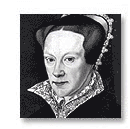| Henry
VIII declared himself head of the Church of England, (Defender of the
Faith), principally because Rome refused him a divorce from Catherine
of Aragon. This was nothing to do with ideas sweeping Europe at the
time propagated by Martin Luther's declaration at Witterburg.
Closer to home, William Tyndal who's first translated
and published the Bible into common English, in an attempt counteract
corruption in the English church. He was engaged in acrimonious controversy
with Sir Thomas More, he was captured in Antwerp by imperialist representatives
and after sixteen months of imprisonment, was tried and condemned on
the 6th October 1536. He was strangled and burnt at the stake. Henry
proclaimed himself head of the church of England, his quarrel with the
church of Rome was for personal rather than ideological reasons.
In Ireland up until about 1534 Henry seemed content
to adopt a policy of simply defending the pale, however after this period
he appears to have changed his policy to one of attack
He dispensed with the Fitzgeralds of Kildare as his power brokers
and replaced them with the Desmond's of Munster and appointed a Lord
Deputy in Dublin who had at his command a standing army. This policy
had far reaching implications for the clans of Ireland.
Seeing Henrys policy as aimed at curbing their
powers and extending English control over their lands. In 1534 the Fitzgerald's
rebelled, they were quickly joined by The O'Connor's, the MacCoughlans,
the O'Mores, the O'Dempsies and the O'Carrolls. These events setting
the scene for one of the most extended period of violence in the history
of Ireland.
In 1536 acts were passed
forbidding people to appeal to Rome or to make payments to the Pope.
Between 1537 and 1541, a number of monasteries were suppressed and their
property confiscated. But, in areas under Irish rule, where the king
had no real power, most of the people were unaware that any changes
had taken place
The affray continued relentlessly until finally
in 1540 the last clan the O'Connor's submitted The terms were that O'Connor
agreed to behave as a royal subject, and to renounce the pope in favour
of Protestantism, and to refrain from attacking the Pale. In return
he was created Baron of Offaly.
By 1547 Brian O'Connor and the O'Mores, were
up in arms again, and attacked the Pale claiming that the English had
not honoured their side of the 1540 agreement and called for the restoration
from exile of the Fitzgerald's of Kildare. The O'Connor and O'More were
immediately proclaimed traitors and their lands were declared forfeit
to the crown.
The pair were soon captured by the Lord Deputy
Captain Bellingham, .The two chieftains were imprisoned in the Tower
of London. A ruthless military campaign ensued and was quickly followed
by the building of roads into Laois and Offaly and the establishment
of fortresses, at what came to be known as Philipstown and Maryborough.
By early 1549, there was a garrisoned passage from the Pale to the midlands.
This intended to be the first step in the plantation of the midlands.
Bellingham, and the new Lord Deputy Sir James
Croft, began introducing new settlers into the confiscated O'Connor's
lands.
The political changes
of this period were more important. They were the work of the new lord
deputy, Sir Anthony St. Leger. He negotiated agreements with more than
40 Irish chiefs and Anglo-Irish lords, by which they surrendered their
lands to Henry and received them back from him as his feudal vassals.
They agreed to recognize Henry as their overlord, and in return he gave
them English titles. For example, Conn O'Neill became Earl of Tyrone
and Murrough O' Brian became Earl of Thomond. In order to give effect
to this new policy, the lord deputy summoned a parliament in Dublin
in 1541 that conferred on Henry VIII the title king of Ireland. The
king was pleased with the success of this new policy, and for the rest
of his reign he allowed the Irish and Anglo-Irish nobles to rule their
lands.
In
1547 Henry died and was succeeded by the boy King Edward VI. England
was ruled by the nobility until 1553 when Queen Mary came to the throne.
Mary pardoned O' Conner and he returned to Ireland, The tower had obviously
not quenched his desire to regain his lost lands, No sooner was O'Connor
back in his home territories than he once more had rebellion on his
mind. He was again captured and imprisoned
Mary reversed the previous  arrangement. Believing that the best
way to subdue Ireland was to introduce colonies of English people into
the country. In 1556, she confiscated the territory of the O'Mores and
O'Connor's in Laois and Offaly and sent English settlers there. The
settlers were to take to Ireland with them English tenants and servants.
They were also to build stone houses, and to provide the Crown with
a certain number of troops when required. In honour of the queen and
her husband, the king of Spain, the area was made into shires and these
were called Queen's County and King's County. But the plantation was
not successful. arrangement. Believing that the best
way to subdue Ireland was to introduce colonies of English people into
the country. In 1556, she confiscated the territory of the O'Mores and
O'Connor's in Laois and Offaly and sent English settlers there. The
settlers were to take to Ireland with them English tenants and servants.
They were also to build stone houses, and to provide the Crown with
a certain number of troops when required. In honour of the queen and
her husband, the king of Spain, the area was made into shires and these
were called Queen's County and King's County. But the plantation was
not successful.
|